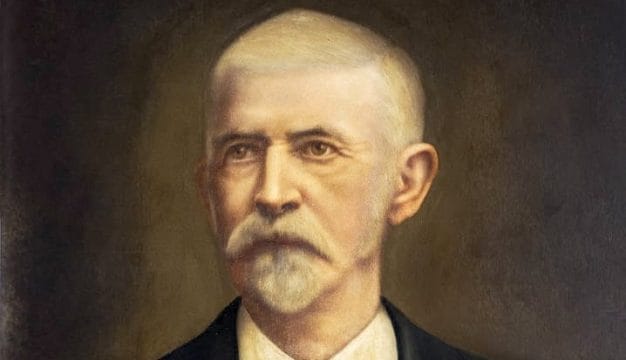Wallace v. Jaffree (1985)
In the 1985 case Wallace v. Jaffree, the United States Supreme Court struck down sections of an Alabama law that authorized a one-minute moment of silence in public schools. The decision had wide-ranging implications for states’ rights advocates and the place of religion in public institutions. The modern debate over school prayer in Alabama stretches back to the 1960s, however. The Supreme Court under Chief Justice Earl Warren had angered southern conservatives for its ruling on school desegregation and stirred up even more resentment in the South when, in Engel v. Vitale (1962) and Abington v. Schempp (1963), it decided that state-sponsored prayer and Bible reading in public schools violated the First Amendment. Alabama’s political leaders were among the loudest opponents of those rulings and, as Gov. George Wallace promised in the early 1960s, many classrooms throughout Alabama ignored the Court and continued to have morning devotionals and Bible readings.
Alabamians’ support for maintaining school prayer prompted state officials to take action in the 1970s and 1980s. In 1978, the Alabama legislature passed a law that allowed teachers to lead students in a time of silent “meditation.” Three years later, Alabama lawmakers added “voluntary prayer” to its moment-of-silence statute. Democratic governor Fob James took the state’s school prayer law one step further when, in 1982, he convened a special legislative session. James proposed that Alabama schoolteachers lead their students in a prayer composed by his 25-year-old son, Fob James III, and the state legislature approved the devotion. Although her husband and son helped spearhead the passage of the new devotional, First Lady Bobbie James also garnered headlines for her outspoken advocacy of prayer in the public schools.
The Supreme Court case Wallace v. Jaffree (1985) dealt a serious blow to the Jameses, as well as the hundreds of thousands of Alabamians who wanted schoolchildren to start every day with prayer. In a 6-3 verdict, the U.S. Supreme Court struck down the state’s 1981 voluntary prayer statute. In 1983, prior to Wallace v. Jaffree, the Eleventh Circuit Court of Appeals had upheld the original 1978 moment-of-silence statute but struck down the 1981 and 1982 additions for being in violation of the First Amendment’s Establishment Clause and earlier Court rulings on school prayer. The state, now led by James’s successor, George Wallace, appealed the Eleventh Circuit ruling to the U.S. Supreme Court. Under this appeal, Alabama only challenged the decision to strike down the 1981 law regarding voluntary prayer. It did not challenge the appellate court’s opposition to the prayer written by Fob James III.
In Justice John Paul Stevens’s majority opinion, the Supreme Court upheld the appellate court ruling. Stevens and five other justices found that the purpose of the 1981 voluntary prayer law was to “endorse religion” and “return voluntary prayer” to the public schools, a goal that many Alabamians admitted proudly throughout this controversy. The Alabama legislature’s endorsement of such activities was, in the words of the majority opinion, “not consistent with the established principle that the government must pursue a course of complete neutrality toward religion.”
In addition to the Jameses and Wallace, at the center of this debate was Ishmael Jaffree, an African American agnostic and civil rights attorney from Mobile who initiated the fight against school prayer and the voluntary prayer law. In the fall of 1981, Jaffree’s son Chioke entered kindergarten, which was taught by a young born-again Christian woman who led the class in prayer before lunch. When the young Jaffree protested this prayer, the teacher told him that he did not have to participate in the pre-meal exercise, but that the prayer would take place. Ishmael Jaffree was appalled at this practice and took his grievance to the courts, which offered him and civil liberties groups the perfect opportunity to challenge Alabama’s recent school prayer legislation. Although he would ultimately win his case against the state, Jaffree was the recipient of intense criticism and became an outcast within Mobile’s black community. Because of their father’s opposition to school prayer, Jaffree’s children were ostracized and ridiculed by classmates.
Wallace v. Jaffree was one of numerous post-World War II decisions that aroused the ire of many Alabamians. Conservative Alabama Christians (mostly white) viewed Wallace v. Jaffree as an affront to states’ rights and, most importantly to them, a rejection of God and Christian morality, even though the 1978 moment-of-silence law remained intact. Wallace v. Jaffree was among several cases that played an influential role in the rise of the modern Christian Right throughout the country and especially in the “Heart of Dixie.”
Additional Resources
DelFattore, Joan. The Fourth R: Conflicts over Religion in America’s Public Schools. New Haven, Conn.: Yale University Press, 2004.
Dierenfield, Bruce J. The Battle over School Prayer: How Engel v. Vitale Changed America. Lawrence: University of Kansas Press, 2007.
Irons, Peter. The Courage of Their Convictions: Sixteen Americans Who Fought Their Way to the Supreme Court. New York: Penguin Press, 1990.
Rieff, Burt. “Conflicting Rights and Religious Liberty: The School-Prayer Controversy in Alabama, 1962-1985.” Alabama Review 54 (July 2001): 163-207.



